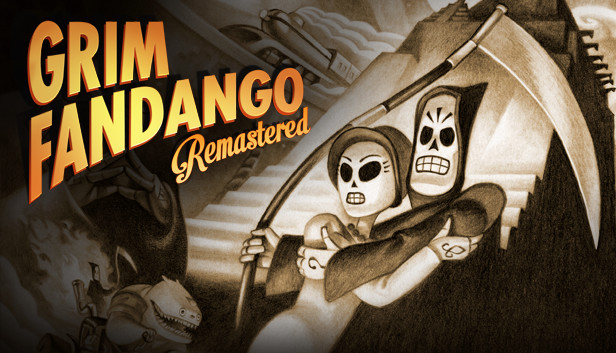Grim Fandango, released in 1998 by LucasArts, is a cult-classic 3D point-and-click adventure game centered around narrative and puzzles. You play as Manuel “Manny” Calavera, a travel-agent selling packages to souls for their trip to the afterlife who eventually embark on an adventure to uncover corruption within your company as you go and find an unfortunate victim of the schemes.
First and foremost, Grim Fandango was a wonderfully designed and written game with fantastic cinematic camera angles and narrative. Beautifully executed visuals and voice acting, and very clear as to why the game is considered a “cult classic.”
Playing Grim Fandango felt extremely reminiscent of summers before 2010 where I would play all sorts of point-and-click educational games such as Zoombinis and all the JumpStart games. This was a time where I didn’t have any walkthroughs nor anyone to help. It was just me, the new and fancy technology, and endless hours at my disposal. I would toil on, clicking here and there, to solve puzzle after puzzle. Hours of bizarre but interesting fun.
But it is no longer 2008 and video games are no longer novel to me. I played through the game with bountiful references to walkthroughs, and frankly, I am in awe of those who played through the entire game without any guides. The solutions to many puzzles are convoluted and….quirky, to say the least. Only with the most subtle cues through character dialogue and luck, alongside a healthy dose of suspension of disbelief can people solve these puzzles. But playing this 23-year-old game after having played others of well-designed gameplay and controls, the retexturing of Grim Fandango does nothing to mask the clunky controls and seemingly non-sequitur logic.

How was I supposed to piece together that I needed to spike Naranja’s drink with hookah water so he’d pass out so I can then steal his dog tags to then feign his death by throwing said dog tags into a sprouted corpse—but wait—you need to provide a metal detector so Membrillo can find Naranja’s dog tags so Naranja’s death can be reported to Velasco so I/Manny can get on the Limbo to go find Meche so you need to go through this whole other thread of going to the cat races and convincing Carla you need her metal detector and–well. You get the idea. (Year 2 was rough). Figuring out the progressing steps for these bizarre puzzles only brought more and more confusion, until finally you finish the storyline and reflect on how bizarre the entire thing really was. Certainly, the sequence of events made sense, but they were such roundabout methods of solving problems. (Really? Freezing your friend’s astronomical amount of vomit with liquid nitrogen so you can walk on top of dominos to defuse a bomb?)
Now, it’s really all in good fun, but it highlights the time the game was made in and for. Computers and relating technologies were still developing and slowly populating regular households in the 1990s. The computer itself was an object of wonder and novelty, as well as the video games that could be played on them. It didn’t matter when game controls were incredibly clunky because the computer itself was still a foreign object. It didn’t matter when game logic was exaggerated and eccentric because the computer itself was a mystical and magical object. The whole experience of sitting in the computer room, booting up the device, and playing a video game was so much more sacred and unique than the modern-day experience of using a computer and playing a game. Since computers are now well understood and easily navigable, as comfortable as walking for most people, there is no extra mysticism of the gaming medium to enhance (or hinder) the gaming experience, and player attention is solely focused on the video game itself, and any awkward game controls are easily attributed to the game itself.
For example, many times when maneuvering the map, the camera angle would change but also make traversing to a different angle difficult. If I had limited gaming experience, I would be fully in awe of the cinematic visuals and transitions, clicking with amazement. However, that was not the case. As much as I adored the angles and presentations, there was clear underlying frustration at the controls despite trying to go in as a blank slate.
For its time, Grim Fandango is a very engaging and quirky game, but played in the modern day where time is no longer a bountiful commodity and computers are no longer novel, it’s quite the frustrating experience (even with a multitude of walkthroughs and guides!)



